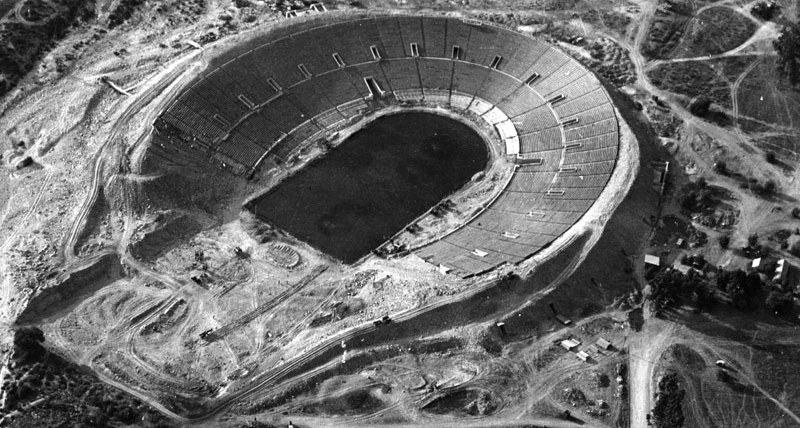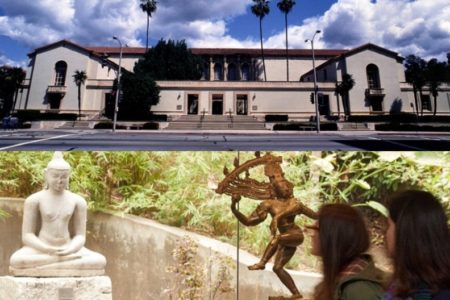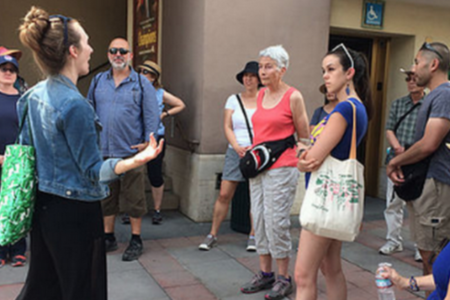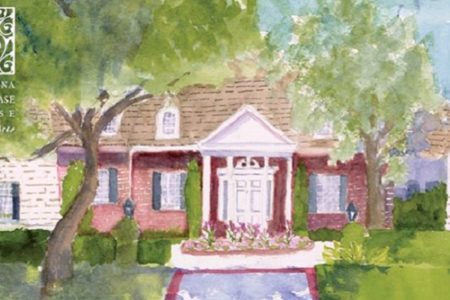
Construction of the South end of Rose Bowl in 1922 [Photo Courtesy of Library of Congress]

Rose Bowl construction in 1922 [Photo Courtesy of Library of Congress]

The Rose Bowl Stadium under construction in Pasadena, California in 1922. [Photo Courtesy of National Register of Historic Places]
On Saturday, the Rose Bowl Legacy Foundation will host ‘The Party of the Century’, the first and only event of its kind in the history of the Stadium, to celebrate the history of a stadium that has had positive impact on over 100 million fans in an unprecedented way. Although tickets are sold out, you can join in the celebrations by buying pieces of history and supporting the Rose Bowl by participating in its once-in-a-lifetime silent auction.
It’s hard to imagine the Arroyo Seco, site of the iconic Rose Bowl Stadium, being nothing but a mostly vacant canyon and dusty rock-strewn wash. But just over 100 years ago, there were no jogging tracks, no golf courses and certainly no Spieker football field. In fact, prior to the time the stadium was built, the site was used as a city dump.
Besides the piles of refuse frequented by racoons and other wildlife, large boulders from the San Gabriel Mountains accumulated by centuries of floods and landslides were strewn around the valley.
But in 1922, William L. Leishman, then President of the Tournament of Roses, decided to build a stadium in the Arroyo Seco. Famous architect Myron Hunt saw there was so much he could do with the boulders. So at a time when there was a stadium-building boom because of the rising popularity of college football, Hunt used the boulders as the foundation for what was to become one of the most famous and treasured landmarks in America.
These boulders were buried in concrete to form the foundation, as were pieces of the lumber that were once wooden bleachers at Tournament Park – at the site of present-day Caltech – which was once home to the Pasadena Tournament of Roses. The old bleachers were hauled by mule-drawn wagons to the Arroyo Seco, and Hunt’s workmen used the wood as framing material for the tunnels.
The tunnels date back to around 1902, and they’re now part of the historic innards of the Rose Bowl.
Construction began in 1922, and Leishman wanted to see the stadium designed similarly to the Yale Bowl in New Haven, Connecticut, his hometown. The Yale Bowl was completed in 1914 and was a wonder at that time. Hunt’s design did turn out to closely resemble it when the Rose Bowl was completed in less than a year.
On Oct. 28, 1922, the horseshoe-shaped Rose Bowl, with 57,000 seats, hosted its first football game, when the California Golden Bears beat the USC Trojans, 12-0. The stadium was officially dedicated on New Year’s Day in 1923, when USC defeated Penn State, 14-3.
The stadium seating has been reconfigured several times since 1922. The open South end of the horseshoe was filled in to complete the bowl and more seats were added. The original benches were wooden and were replaced by aluminum seats in 1969.
An all-new grandstand was installed in 1971, as were new lounge seats.
Prior to the 1980 Rose Bowl Game, new red seat backs were added on 22,000 seats. More improvements were made when UCLA moved to the stadium in 1982 and before the 1984 Summer Olympics, resulting in more new seat backs for 50,000 seats.
The Rose Bowl reigned for many years as having the largest football stadium capacity in the United States until it was eventually surpassed by Michigan Stadium with a capacity of over 107,000.
The stadium’s press box was updated before the 1962 Rose Bowl tournament, with an elevator and two rows of seats added. It was again refurbished for UCLA’s move in 1982 and the 1984 Summer Olympics.
In the early 1990s, the stadium’s caretakers saw some unforeseen problems due to the stadium’s age and began a series of major renovations. Many upgrades completed by 2013, but because of the increased construction cost, a plan to add more new restrooms had to be deferred, as were the addition of new concession stands, the historic field hedge, new entry-gate structures and ribbon boards.
‘This is the mecca, this is the mansion at the end of the yellow brick road’
In 2013, as the Rose Bowl prepared for the 100th Rose Bowl Game, the caretakers started the Rose Bowl Brick Campaign, a joint effort between the Pasadena Tournament of Roses Association and the Rose Bowl Legacy Foundation, to help pay for some of the cost of the renovations.
The campaign encouraged donors to leave their legacy on bricks featuring a logo of the Tournament of Roses and their names placed in the Rose Plaza, located in front of Gate A at the Stadium. Because of the Brick Campaign, college football and music fans and community members now hold a symbolic spot at America’s Stadium while directly supporting the protection and preservation of the Rose Bowl Stadium.
Later, a large 30-by-77-foot LED display board was added to the north end of the stadium as a part of the renovation process.
The old 1922 Rose Bowl locker room was restored in 2017 and converted into a museum. Sections in the museum are dedicated to the construction of the Rose Bowl, the Rose Bowl games, UCLA football, and the NFL Super Bowl games played at the Rose Bowl.
In 1999, Sports Illustrated listed the Rose Bowl at number 20 in the Top 20 Venues of the 20th Century. In 2007, the sports magazine named the Rose Bowl the No. 1 venue in college sports.
Brandi Chastain, who scored a World Cup-winning penalty shootout goal against China in the 1999 FIFA Women’s World Cup final, joined the Rose Bowl Stadium community in remembering how it was to be in such a historic structure in Pasadena.
“It’s been such a pleasure to be a part of something so unique and special like the Rose Bowl Stadium,” she said in a message for the Stadium’s 100th anniversary. “We played our hearts out in front of young girls who might have never seen soccer live before and helped them fall in love. It’s incredible.”
A message from the late Keith Jackson, famed sports commentator, journalist, author, and radio personality known for his career with ABC Sports, is also printed on the Rose Bowl page commemorating the Stadium’s history.
“Well, this is the mecca, this is the mansion at the end of the yellow brick road. For anyone that is a college football fan this is the place you want to come.”
On Saturday, the Rose Bowl Legacy Foundation will host ‘The Party of the Century’, the first and only event of its kind in the history of the Stadium, to celebrate the history of a stadium that has had positive impact on over 100 million fans in an unprecedented way.






